Wine Lister’s Founding Members’ tasting (the second if its kind) was held last week in the most beautiful surroundings at Ten Trinity Square Private Club. Aside from showcasing how Wine Lister data relates to the actual liquid in the bottle, these tastings are an opportunity to thank friends and supporters of Wine Lister, from subscribers to Founding Members.
We were excited to share news of upcoming developments with our guests, including the imminent expansion of Wine Lister’s coverage (almost doubling from the current 20,000 wines scored), as well as the addition of a new rating criterion. Watch this space!
Wine Lister’s Founding Members, more than 50 major players in the international wine trade, make an invaluable contribution to Wine Lister’s research by sharing their market insights with us on a biannual basis. It is Wine Lister’s role as a fine wine intelligence agency to combine this qualitative information with quantitative data to shed analytical light on fine wines from across the world, for example in our regional reports and factsheets.
In one recent trade survey we asked Founding Members the question, “Which wines do you consider hidden gems (wines you rate highly but which are under-appreciated)?”. The responses inspired the wonderfully varied (but consistently delicious) selection of 24 hidden gems tasted last Thursday (see the full list of wines below).
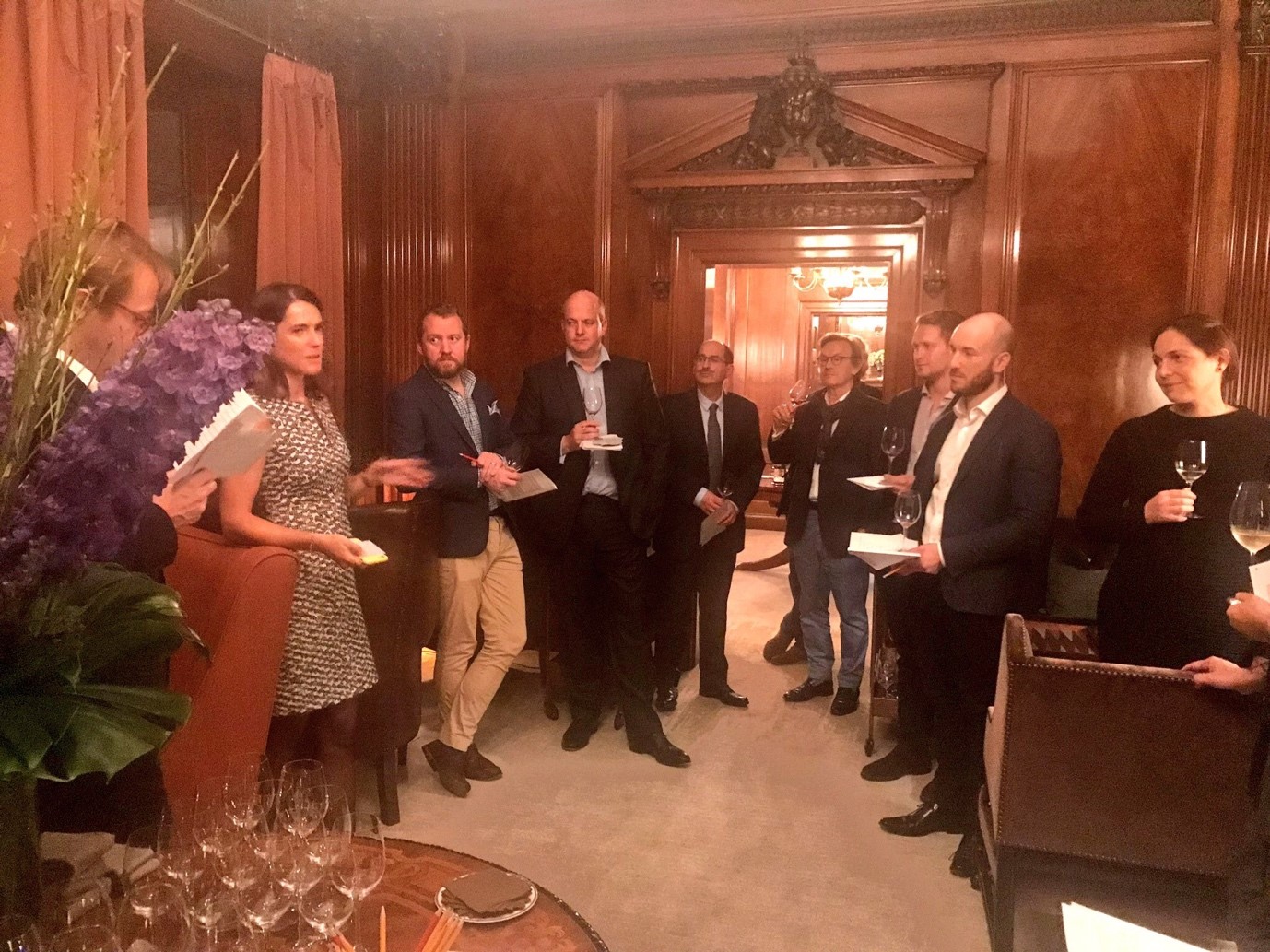
From left to right: Antoine Forterre, Ella Lister, Giles Cooper, Henry Donne, Pascal Kuzniewski, Pierre-Marie Boury, Anthony Vertadier Mabille, Gareth Kristensen, Sara Guiducci.
In an illustration of how Wine Lister brings together market research with hard data, the “raw” hidden gems selected by our Founding Members are then overlaid with critics’ ratings, restaurant presence, and search frequency data. This gives us the final Hidden Gems presented on the Wine Lister website. In other words, Hidden Gems are wines that are rarely found in top restaurants, and not often searched for online, but which receive high ratings from our partner critics, and have been singled out by our Founding Members as not garnering due attention.
The Founding Members’ “raw” hidden gems featured several Bordeaux wines, including 10 out of the 24 wines shown in the tasting. However, none of these achieve final Hidden Gem status due to their already established brands.
To liven up the evening, we encouraged guests to play “guess the score” – to see how closely they could estimate the Wine Lister score of the wines that they tasted. All the wines were showing beautifully, but Pichon Longueville Comtesse de Lalande 2005 was the wine that our guests successfully identified as having the highest Wine Lister score of the tasting, despite their guesses sitting an average 44 points below Pichon Comtesse 2005’s actual Wine Lister score of 931.
Conversely, Henschke Mount Edelstone Shiraz 2014, Pédesclaux 2014, and Louis Roederer Brut Premier were all awarded higher scores on average by our guests than their official Wine Lister ratings, but the biggest difference was for G.D. Vajra Barolo Albe 2013. It was awarded an average score of 746 by our guests, 73 points above its actual Wine Lister score, which is brought down by a very low Economics score of 124, due to very little price movement or liquidity. This illustrates how the data-driven elements of Wine Lister scores complement the tasting component.
The wine where our guests came closest with their guesses, just 10 points out, was Brane-Cantenac 2005, estimated at 840 compared to its real Wine Lister score of 850.
Congratulations to the game’s winner, Anneka Swann of BI Wines & Spirits, who was just 37 points out on average. We would also like to thank all our other guests for their valiant efforts at guessing the scores: Adam Brett-Smith, Andrea Frost, Chad Delaney, Charles Metcalfe, James Jackson-Nichols, Nicolas Clerc, Richard Stow, Rupert Millar, Tahir Sultan, and Will Hargrove.
Wines featured in the tasting: Louis Roederer Brut Premier, Philipponnat Clos de Goisses 2007, E. Guigal Condrieu La Doriane 2016, Casa Lapostolle Clos Apalta 2014, Seña 2010, Henschke Mount Edelstone Shiraz 2014, Isole e Olena Syrah Collezione Privata 2011, Tenuta San Guido Guidalberto 2016, Produttori del Barbaresco Barbaresco 2014, G.D. Vajra Barolo Albe 2013, G.D. Vajra Barolo Bricco delle Viole 2009, Domaine Duroché Gevrey-Chambertin Les Jeunes Rois 2015, Domaine Duroché Chambertin Clos de Bèze Grand Cru 2015, Domaine Tempier Cuvée Cabassou 2007, Château La Gaffelière 2014, Le Marquis de Calon Ségur 2014, Château Haut-Bailly La Parde 2012, Château Les Carmes Haut-Brion 2014, Château d’Issan 2011, Château Branaire-Ducru 2012, Château Pédesclaux 2014, Château Pichon Longueville Comtesse de Lalande 2005, Château Brane-Cantenac 2005, Château Lafon Rochet 2010.
Earlier this year Wine Lister compared the top 50 wines by Quality score from Old World and New. The outcome revealed a 35-point gap between the two, with an average Quality score for the 50 best New World wines of 948. This week, Wine Lister dips its toes back into New World waters to examine the top five Argentinian wines by Wine Lister score.
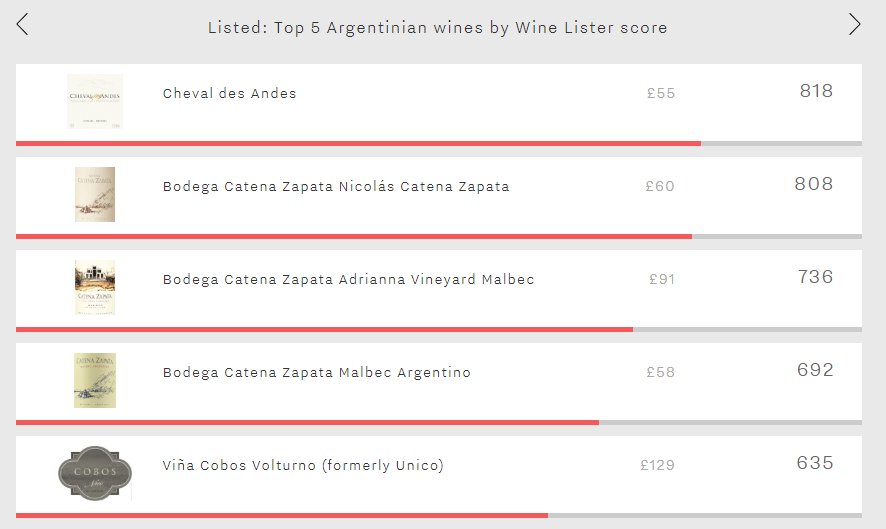
Interestingly, the winner of this week’s top five can perhaps be considered as belonging to both Worlds. Cheval des Andes, the joint venture from Terrazas de los Andes and Pierre Lurton of Cheval Blanc, has an overall Wine Lister score of 818. Unsurprisingly, Cheval des Andes shows the clear benefit of association with its Old World stablemate through a Brand score of 862, the highest of the group. This is thanks to presence in 15% of the world’s best restaurants, and a search frequency ranking as the 400th most-searched-for wine on Wine Lister’s database. It has the lowest Quality score of the five (845) – and is notably the only one of the group whose Quality score is not its strongest asset – but is also the least expensive at £55 per bottle.
Bodega Catena Zapata shows impressive presence in this week’s top five, taking the next three spots. In second place overall is Nicolás Catena Zapata with a Wine Lister score of 808. Nicolás has the highest Quality score of the group (921), however its brand strength should not be overlooked. With the second-highest Brand score of this week’s top five (828), it actually ranks 10 places higher for search frequency than New World super-brand Cheval des Andes.
Although Catena Zapata’s Adrianna Vineyard Malbec comes next for overall Wine Lister score, it is the Bodega’s Malbec Argentino (in fourth place overall) that comes next for Quality, with a score of 909. Its overall score (692) doesn’t maintain the dizzying heights set by its Quality score – nevertheless still sitting in the “strong” section of the Wine Lister 1,000-point scale – due in part to a lower Brand score (705), but mostly to a much weaker Economics score (181).
Bookending this week’s top five is another wine which might also be considered as originating from more established roots, though this time hailing from elsewhere in the New World, and more specifically, producer Paul Hobbs. Viña Cobos’ Volturno has an overall score of 635. It paints a similar picture to Catena Zapata’s Malbec Argentino, in that despite a high Quality score (902), its overall score is hindered by modest Brand and Economics scores (436 and 380 respectively).
Even though Austria might not be the first place that springs to mind when one thinks of the best wines in the world, it is definitely a place of fine, elegant wines, as confirmed by this week’s top five, which looks at the best Austrian whites by Quality score. With all of the five achieving Quality scores of over 900-points – thus making it into the “strongest” category on Wine Lister’s 1,000-point scale – there is no reason not to have Austria in mind when thinking of top quality wines.
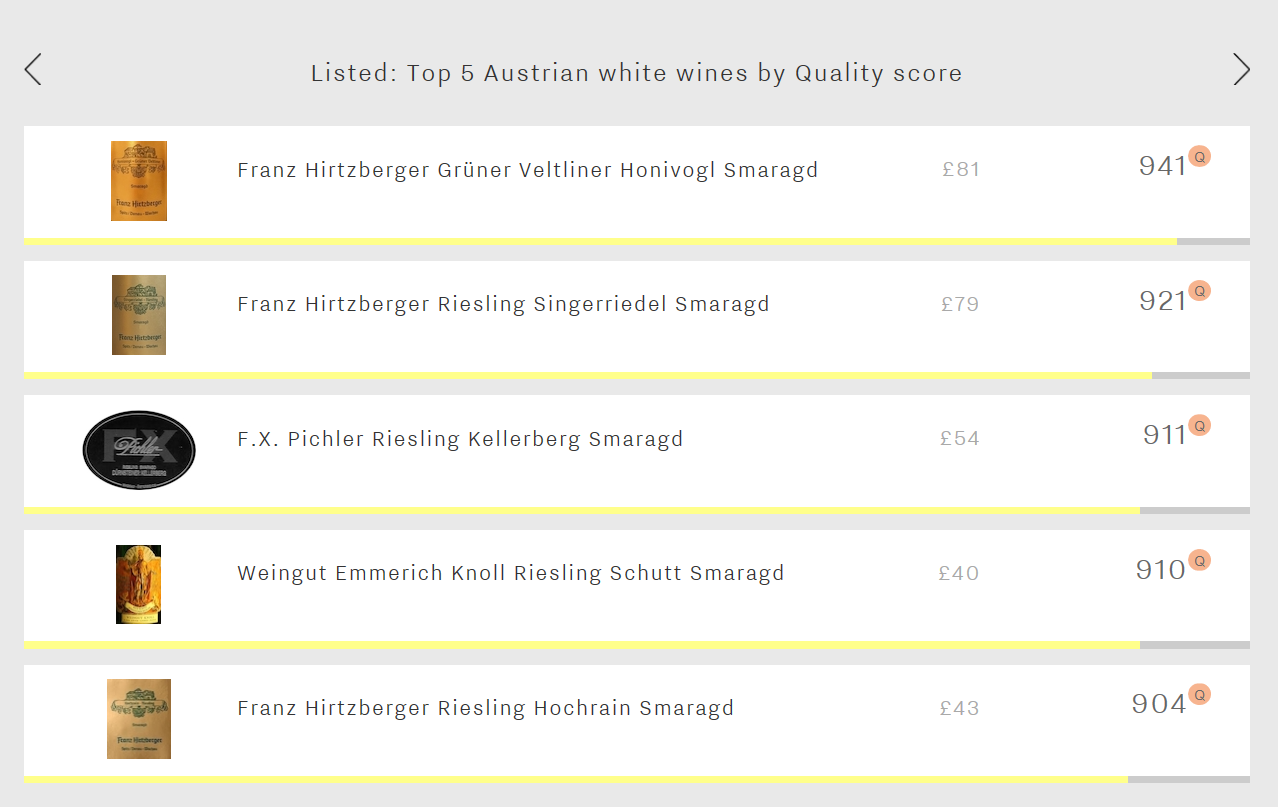
Notably, Franz Hirtzberger produces three of this week’s top five: his Grüner Veltliner Honivogl Smaragd, Riesling Singerriedel Smaragd, and Riesling Hochrain Smaragd demonstrating that he is indeed one of the greatest Austrian producers of dry whites. Leading the way this week is his Grüner Veltliner Honivogl Smaragd with a Quality score of 941. Interestingly, it is the only Grüner Veltliner of the group, with Austria’s national grape otherwise surrounded by Rieslings. At £81 per bottle, it is this week’s most expensive choice. However, it is also Jancis Robinson’s favourite of the five, Wine Lister’s UK partner critic awarding it an excellent average score of 18/20. She was particularly impressed by the 2013, giving it a rating of 18.5/20 and writing: “Spectacularly rich nose. Very ample, intense and flattering. Smoked meat! Kerpow! Not flabby. Great structure. Amazing”.
Franz Hirtzberger’s Riesling Singerriedel Smaragd comes next, and backs up its phenomenal Quality score (921) with this week’s best Brand score (760). Even though its Economics score is considerably lower (503), the Singerriedel is Austria’s overall top-scoring wine, with a Wine Lister score of 781.
F.X. Pichler’s Riesling Kellerberg Smaragd comes in at number three, with a Quality score of 911. This is Vinous’ favourite of the five with an average score of 95/100. Its Quality score is however pulled down slightly by its relatively low average wine life of seven years, making it the shortest-lived wine of the group (which averages nine years). However, it has the most stable price of this group, with volatility of just 2.7%, well below that of this week’s number one, Franz Hirtzberger’s Grüner Veltliner Honivogl, which has volatility of 11.8%.
The two remaining spots are filled by Weingut Emmerich Knoll Riesling Schutt Smaragd in fourth place, and the third wine from Franz Hirtzberger this week, his Riesling Hochrain Smaragd, in fifth place. Although the two come in last in this particular race, both still achieve excellent Quality scores (910 and 904 respectively), partly due to Vinous awarding both an average score of 93.5/100.
Wine Lister periodically studies the movements of wines in and out of the four Wine Lister Indicator categories. One of these, Buzz Brands, denotes wines that achieve outstanding online popularity (measured through search rankings based on monthly searches on Wine-Searcher), and presence in the world’s best restaurants.
After analysing newcomers to the Buzz Brand segment in June, Burgundy dominates once again in our findings for October. Red Burgundy, and in particular, Gevrey-Chambertin, takes three out of the four places of this month’s new Buzz Brands.
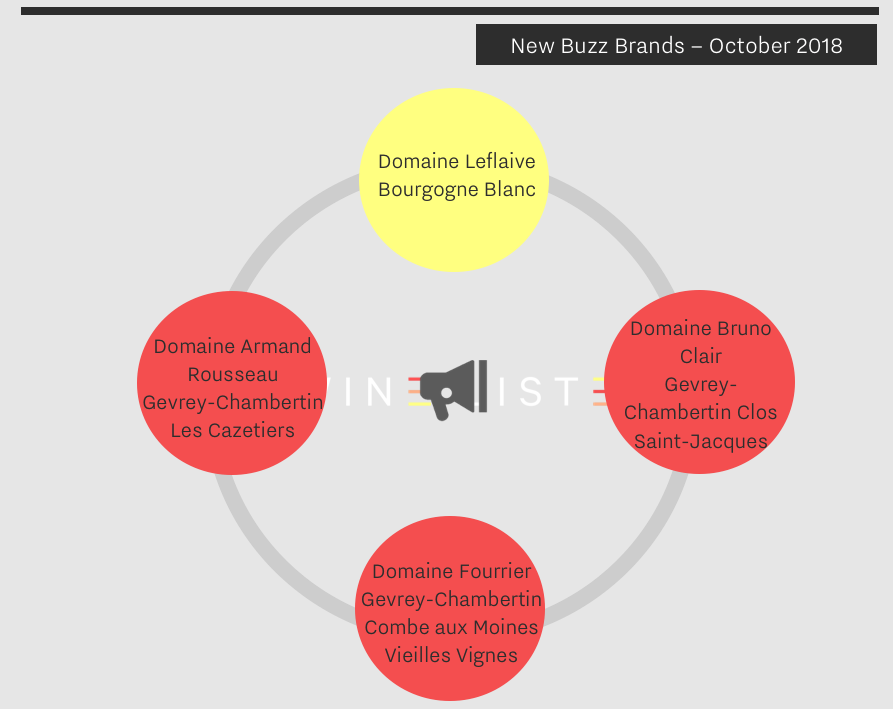
However, it is in fact the only white, Domaine Leflaive’s Bourgogne Blanc, that achieves the highest Brand score of the group at 815. All of the Domaine Leflaive wines on Wine Lister are now Buzz Brands but one – their most expensive Grand Cru, Montrachet (at £6,059 per bottle compared with £218, the average price of the rest). Indicative, maybe, of drinkers being priced out of the top wines and refocussing their interest lower down the ladder.
Perhaps it is also the sign of a good brand strategy in action, with the rising profile of the Domaine’s top wines filtering all the way down to the regional wines, via the premiers crus. The new addition of the regional offering here follows two previous new Leflaive mentions in Wine Lister’s last Buzz Brand audit (of Puligny-Montrachet Les Combettes and Meursault Sous le Dos d’Ane).
Of the three reds, two hold the same Brand score of 722, and near identical Brand profiles (see restaurant presence and search rank in the image below). The Gevrey-Chambertin Clos Saint-Jacques is the first of Bruno Clair’s wines to become a Buzz Brand. Domaine Fourrier’s Combe aux Moines Vieilles Vignes has the highest Quality score of all three new red Burgundy Buzz Brands with a score of 889. This, coupled with a slightly better Economics score helps bring it very slightly ahead for overall Wine Lister score.

Though Domaine Armand Rousseau’s Les Cazetiers is third of the Gevrey group qualitatively, it is geographically sandwiched between the first two. These wines together form a neat representation of three of the best premier cru vineyards of Gevrey-Chambertin. Incidentally, this is the last of Rousseau’s wines on Wine Lister to achieve Buzz Brand status. The domaine’s highest Brand score is won by the better-known Clos Saint-Jacques (unsurprising given that it owns roughly one third of the entire vineyard parcel) with a Brand score of 964.
Wine Lister’s first in-depth study of Burgundy published earlier this year was named “Mercury Rising” for a reason. With prices climbing more quickly than any other fine wine region, it is hard to consider the possibility of finding Burgundies of “reasonable value”. This week’s Listed blog brings you the top five Côte de Nuits by Quality score that won’t completely rupture the bank (or in other words, for under £200).
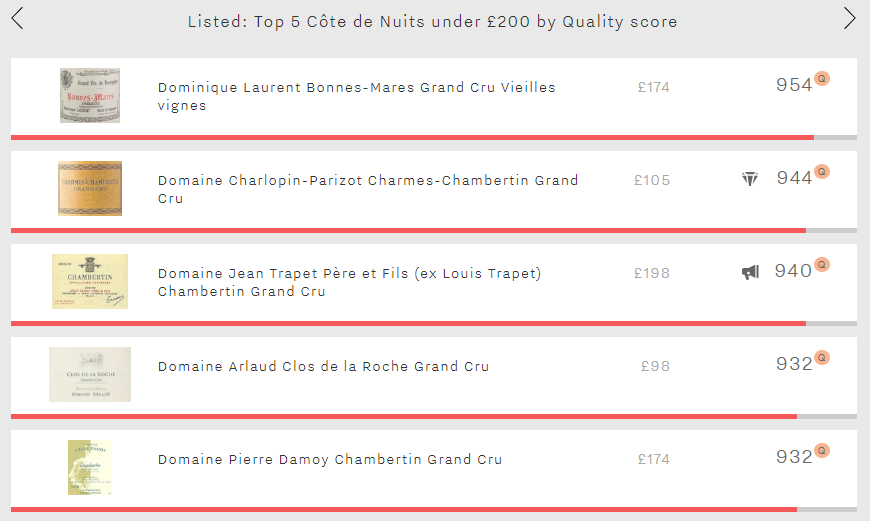
Dominique Laurent takes top spot this week with his Bonnes-Mares Vieilles Vignes, which has a Quality score of 954. Whilst this score sits comfortably amongst the highest of all Bonnes-Mares, the per bottle price of £174 does not – indeed, it is just under five times lower than the combined average price of the other eight best Bonnes-Mares on Wine Lister. Perhaps the lower price can, at least in part, be explained by its modest Brand score (531). For example, despite its Quality score sitting just one point higher, Georges Roumier’s Bonnes-Mares records a Brand score of 934, and is £1,046 more expensive.
In second place is Domaine Charlopin-Parizot’s Charmes Chambertin, with a Quality score of 944. Its high quality is not yet accompanied by an equal level of consumer recognition. With the lowest Brand score of the five (445) resulting from presence in only 2% of the world’s best restaurants and a search frequency ranking of 2,335 (of the c.4000 wines on Wine Lister), this Charmes Chambertin is a Hidden Gem (Wine Lister’s indicator that identifies under the radar wines that warrant discovery).
Domaine Jean Trapet Père et Fils’ Chambertin takes third place this week with a Quality score of 940 and just sneaking in under the £200 mark. While in third place for Quality, it has the highest overall Wine Lister score of the lot (906), thanks to its Brand (868) and Economics (896) scores. Indeed, it beats the combined average scores of the other four wines in this week’s top five in both categories by 310 and 319 points respectively.
The remaining two spots are taken by Domaine Arlaud Clos de la Roche, and Pierre Damoy Chambertin, each with a Quality score of 932. In addition to being by far the cheapest option of this week’s top five (£98 per bottle on average), Arlaud Clos de la Roche’s price is also the most stable, with volatility of just 5.7%. Conversely Damoy Chambertin’s price is the most volatile (8.7%), possibly the result of strong growth rates over both the long and short-term, having recorded a three-year compound annual growth rate of 15.6% and having added 6.5% to its price over the past six months alone.
The 2018 will be a five-star vintage for Chianti Classico wines according to Giovanni Manetti, newly-elected president of the appellation’s Consorzio. The growing season was “very regular”, with no extreme weather events, and normal picking times. Thanks to healthy grapes, ripe yet fresh, Manetti believes the vintage will be characterised by “harmony”. The DOCG appellation is set to produce c.270,000 hectolitres, back to normal production levels after a less abundant 2017.
On Monday 24th September at Fontodi, Manetti’s winery in Panzano, harvest was well underway. It had not rained for 22 days, and the ground was dusty. However, Manetti explained that in Panzano, while hot, temperatures had not risen above 36˚C, and that nights had been cool. At Castello di Fonterutoli, 15km further south, Giovanni Mazzei confirmed the heat had been nothing on 2015, when temperatures rose above 45˚C.
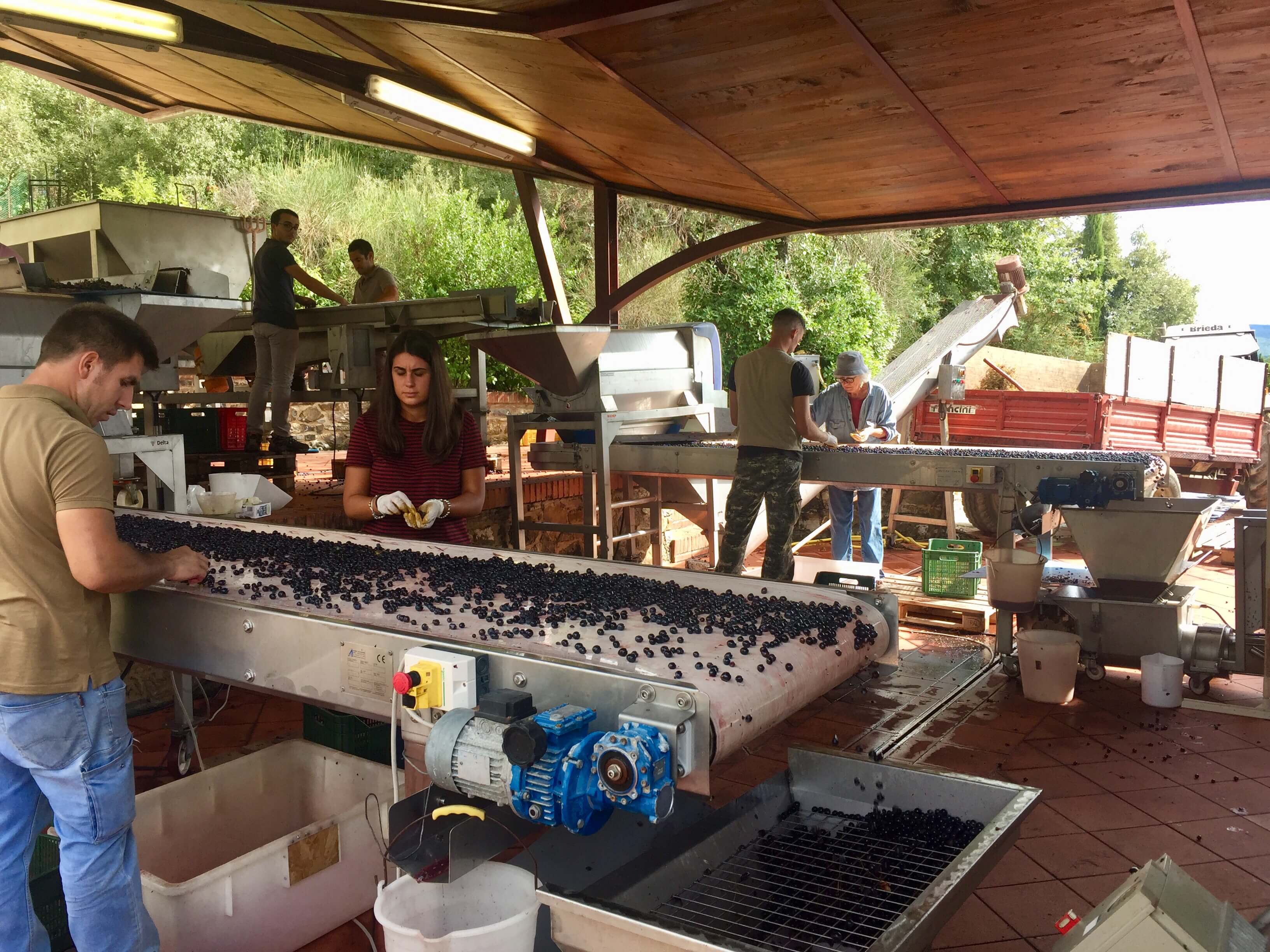
Quality control at Fontodi’s sorting tables in Chianti Classico
However, Mazzei was somewhat less sanguine about the 2018, citing humid mornings as a challenge. Having picked one third of the estate’s production by Monday, the next fortnight will be a race against rot. Mazzei predicts the vintage might fall between the opulent 2015s and the structured 2016s in terms of quality and style.
Towards the coast, in Bolgheri, the Merlot harvest is almost finished, and “the fermenting wines are silky and fragrant,” according to Axel Heinz, Estate Director at both Ornellaia and Masseto. Heinz is grateful for “excellent conditions during September with sunny and mostly dry weather, occasionally hot day temperatures but cool nights”. In Bolgheri, “mildew and humidity have been challenging,” he states, ”but we were able to bring healthy fruit to full ripeness,” recounts Heinz, who says yields in 2018 are normal. He predicts “a more delicate vintage, like 2013.”
Moving down the coast, in the Maremma, Elisabetta Geppetti, owner of Fattoria Le Pupille, spoke of regular climatic conditions leading to “a good year”. The first lot of Merlot for Geppetti’s flagship wine Saffredi is already vinified, and, she says, “marvellous”. She is delighted with her Cabernet Sauvignon too, and relayed the view of Le Pupille’s consultant oenologist Luca d’Attoma, that the grape has thrived throughout the whole southern part of Tuscany. Meanwhile Sangiovese has ripened less evenly.
Back inland, in Sangiovese’s heartland, Montalcino, the picture is less clear cut, due to excessive rain in spring and early summer. “Winemakers had not seen this kind of weather since the nineties,” explained Giacomo Pondini, Director of the Brunello di Montalcino Consorzio.
There has been “too much humidity in the air”, according to Gianfranco Soldera, with an “almost tropical” summer (a similar story to the picture recounted in our Bordeaux harvest report). At Case Basse, Soldera’s cult winery, 2018 has been “a year of suffering”, with mildew, oidium, and “mould in general”. To combat this, a team of 20 people has been combing the vineyard removing bunches non-stop since June.
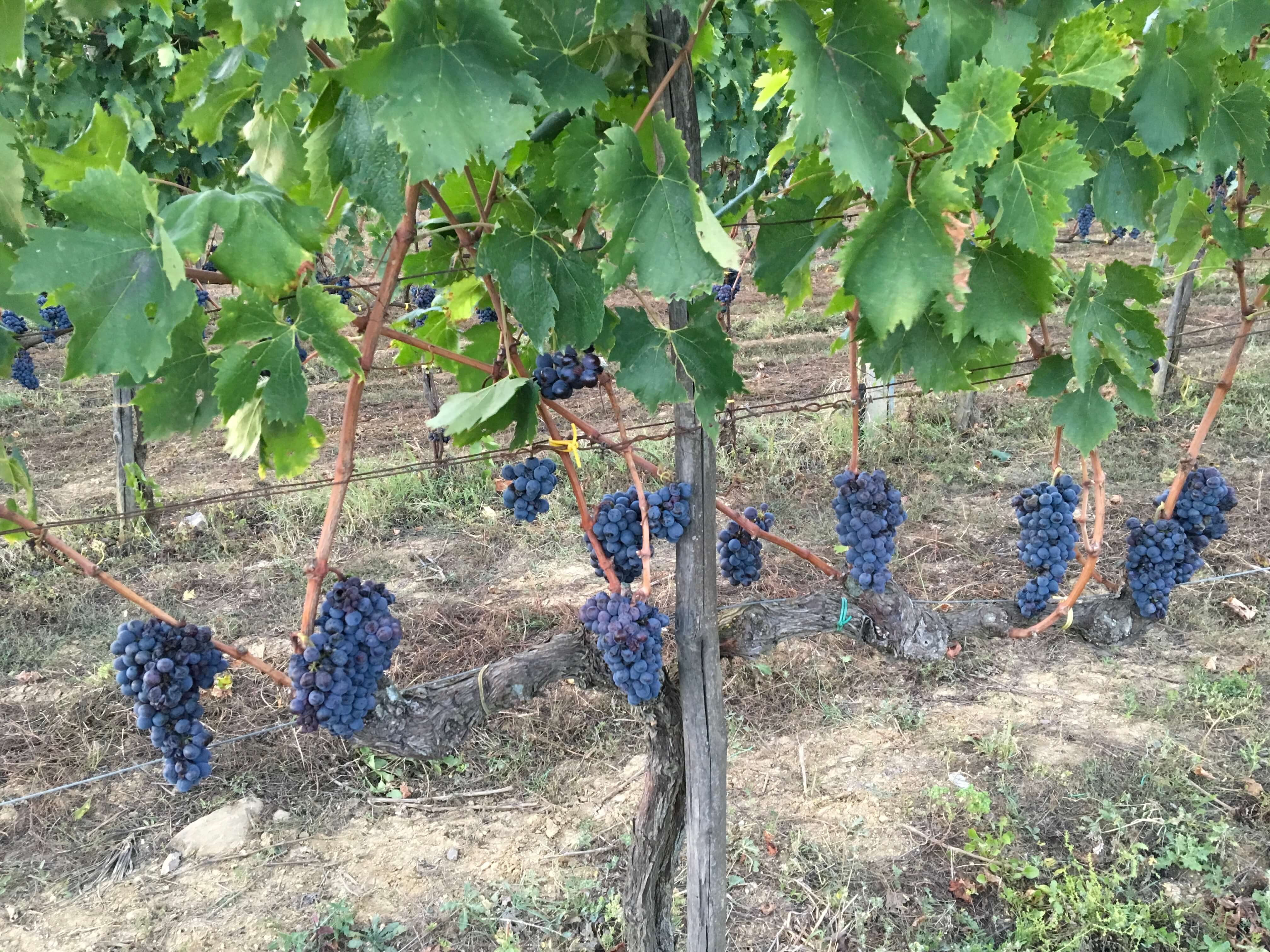
Remaining bunches after extreme selection at Soldera’s Case Basse in Montalcino
Unlike in 1989, the only year when Soldera didn’t make a wine because of too much rain, he was “ready for the challenge” this time round, and believes he will still make a great wine in 2018, albeit in very small quantities. For Soldera, rain is the enemy of vine-growing, and he rejoiced in the exceptionally dry growing season of 2017, “a year of fun”, where the vines drank mineral-rich water from the ground. Incidentally, the 2017, tasted (or rather drunk – as spitting is banned at Case Basse) from its Garbellotto cask, is incredible: alluring, alive, pure, and long.
The owner of neighbouring wineries Caparzo and Altesino, Elisabetta Gnudi puts 2018 somewhere between a four- and five-star vintage. To absorb the humidity, her team used clay dust on the vines, “like using baby powder,” she explained. Again echoing the story in Bordeaux, she reckons that “true organic vineyards haven’t harvested a single grape this year.”
At Argiano, Sales Manager Riccardo Bogi also described a less plain-sailing vintage than in Chianti. On top of the heavy rain, a hailstorm in July wiped out 25% of the crop in some vineyards. However, positioned high up on the hill of Argiano, wind in August meant the winery was able to counter rot with copper and sulphur, although the “agronomist didn’t get a vacation”, quipped Bogi. Like Heinz in Bolgheri, he expects 2018 to share characteristics with the elegant 2013s, saying they won’t have intense colour or structure.
There was a dramatic change in the weather on Monday, with temperatures dropping and strong winds picking up, which lasted throughout our three-day visit. While half of the appellation’s Sangiovese has already been harvested, and wineries are “happy with the quality,” Pondini hopes that, “the other half may benefit from this sunny, cool, windy week”.
As ripe, healthy grapes are being picked across Bordeaux, winemakers are anything but shy about the potential of the 2018 vintage. “2015 and 2016 are five-star vintages, but 2009 and 2010 are five-star plus,” said Olivier Bernard, president of the Union des Grands Crus Classés de Bordeaux. At his own property in Pessac-Léognan, Domaine de Chevalier, “2018 has 2009-2010 potential,” he declared on Wednesday morning, just as the red harvest was beginning.
Bernard is not the only Bordeaux producer daring to hope that the region has another great vintage on its way into the cellars. Part of the Wine Lister team is just back from four days in Bordeaux, where we visited châteaux on right bank and left, from Saint-Estèphe in the very north to Pessac-Léognan south of the city. We tasted lots of berries, spoke to oenologists, and even picked some grapes.
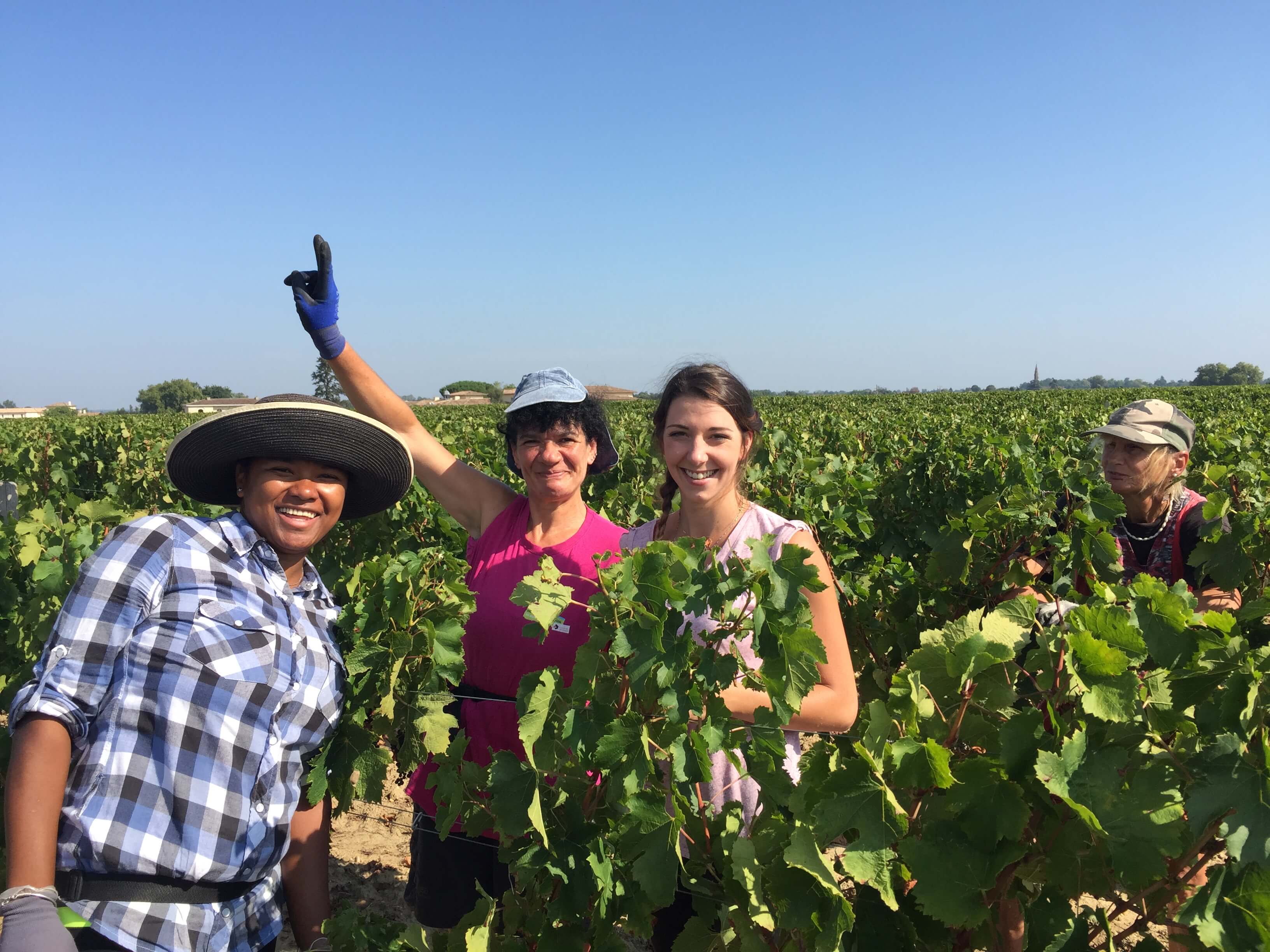
Members of the picking team at Petrus during the 2018 harvest
Producers’ smiles were big, and all the signs were promising, but after such a rollercoaster growing season, can 2018 really match up to the historic pair of 2009 and 2010? I asked straight-talking winemaking consultant Stéphane Derenoncourt if this comparison was justified. “More 2010,” he confirmed, adding, “There are going to be some delicious wines.”
Spring in Bordeaux was interminably wet, and mildew a serious threat throughout the region. “We thought there might not be a harvest at all,” recalls Nicolas Audebert, Managing Director of Châteaux Canon and Rauzan-Ségla. “It rained non-stop, and with high humidity and the high temperatures in June, it was almost tropical,” he said. Some members of Audebert’s team had never seen mildew so rife in 40 years of working the vines in Bordeaux.
Many top producers were affected, especially those practising organic or biodynamic viticulture and therefore unable to treat the vines systematically to protect from the fungus. In Saint-Estèphe, at the top of the Gironde Estuary nearest the Atlantic Ocean, Lafon-Rochet, organic since 2010 (though uncertified), abandoned the practice this year, and for good, in order to fight the rain.
However, mildew “is primarily a problem for quantity, rather than quality,” explained Axel Marchal, consultant and researcher at Bordeaux University, because the affected grapes are easily removed and discarded. “Badly hit vines can see a slight quality impact too, if the stress caused to the plant is enough to delay maturity,” he clarified.
At Canon in Saint-Emilion, quantity lost to mildew was recouped by less green harvesting later in the season. Its larger Margaux sister property, Rauzan-Ségla, was not so lucky, and yields will be lower than average. The two properties are organic (again not certified), allowing them to treat the vines when “really necessary”. However, many strictly organic or biodynamic estates will produce much smaller quantities of wine this year, meaning yields will be very varied from château to château, ranging from around 15 hl/ha to 50 hl/ha or more.
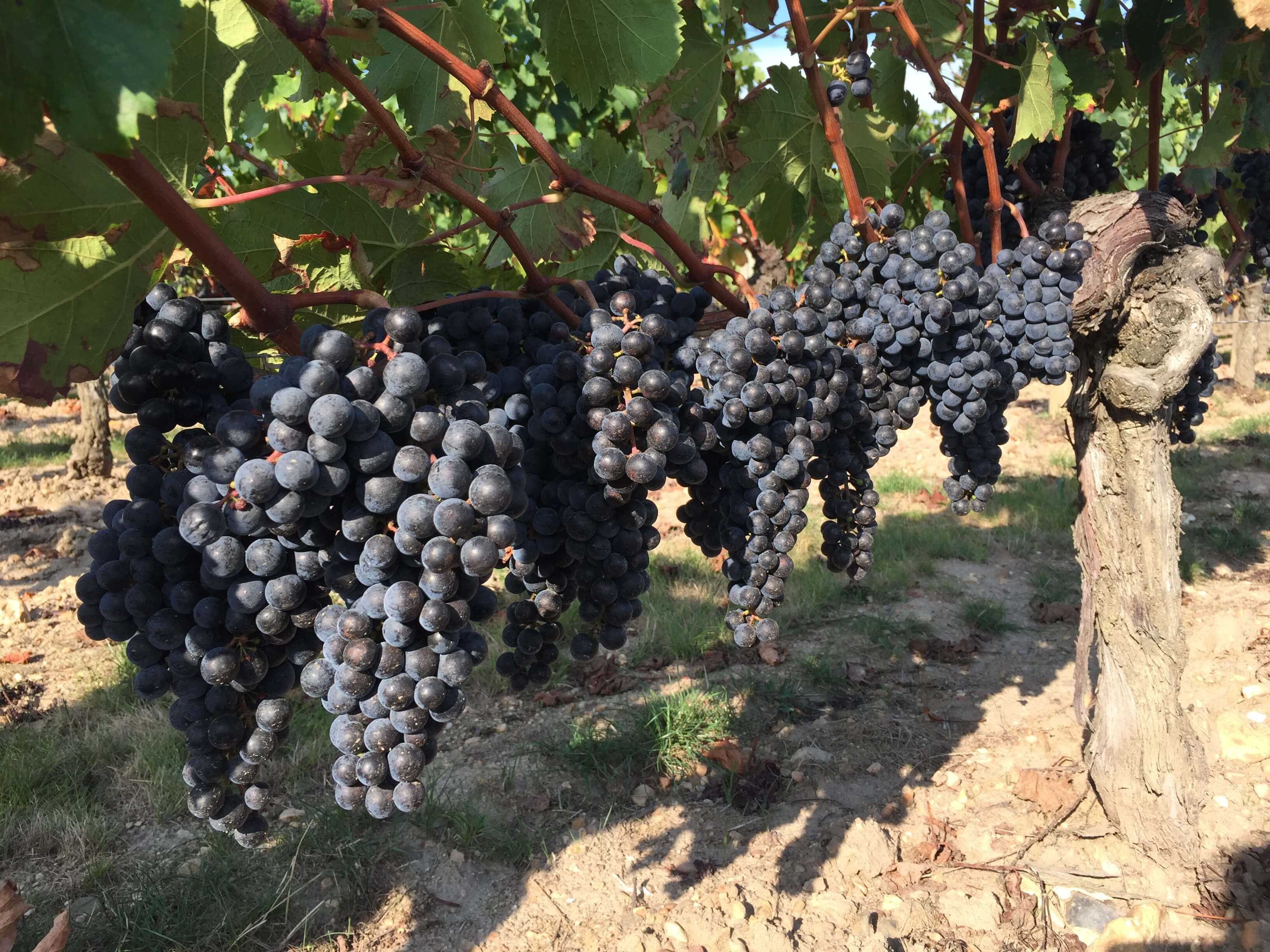
Grapes ripe for picking at Petrus
Potential quantity started off high, with the rain acting as “a signal for the plant to produce lots of fruit,” explained Bernard. The incessant spring downpours had another positive effect: they left the ground full of water, helping the vines to withstand the hot, dry summer that unfolded from 20th June onwards. “Looking at our vines, it’s hard to believe it’s been one of the driest summers in 50 years,” marvelled Bernard.
Audebert thinks the 2018 Canon will be soft and rounded, but livelier than 2005 or 2009, with phenolic potential above that of the 2010 (which of course is renowned for its intense colour and high levels of ripe tannin). When I asked if it could be as good as 2010, my question was met with silence and a roguish smile.
This week, our Listed blog focuses on Spain’s strongest Brands. Unsurprisingly, and fittingly as we creep into autumn, all are red. It will probably also come as no shock that Bodegas Vega-Sicilia features prominently – filling an impressive three out of five spots on the list, including the top two.
Wine Lister’s Brand score combines a measure of a wine’s prestige – as indicated by its visibility in the world’s top restaurants – with its level of online popularity – calculated by ranking each of the 4000+ wines in our database by monthly search frequency on the world’s most visited wine site, Wine-Searcher. Four of this week’s top five also qualify as Buzz Brands – Wine Lister’s group of wines that perform particularly well when it comes to restaurant presence and online popularity, or are demonstrating a recent growth in popularity, and which are identified by the fine wine trade as trending or especially prestigious.
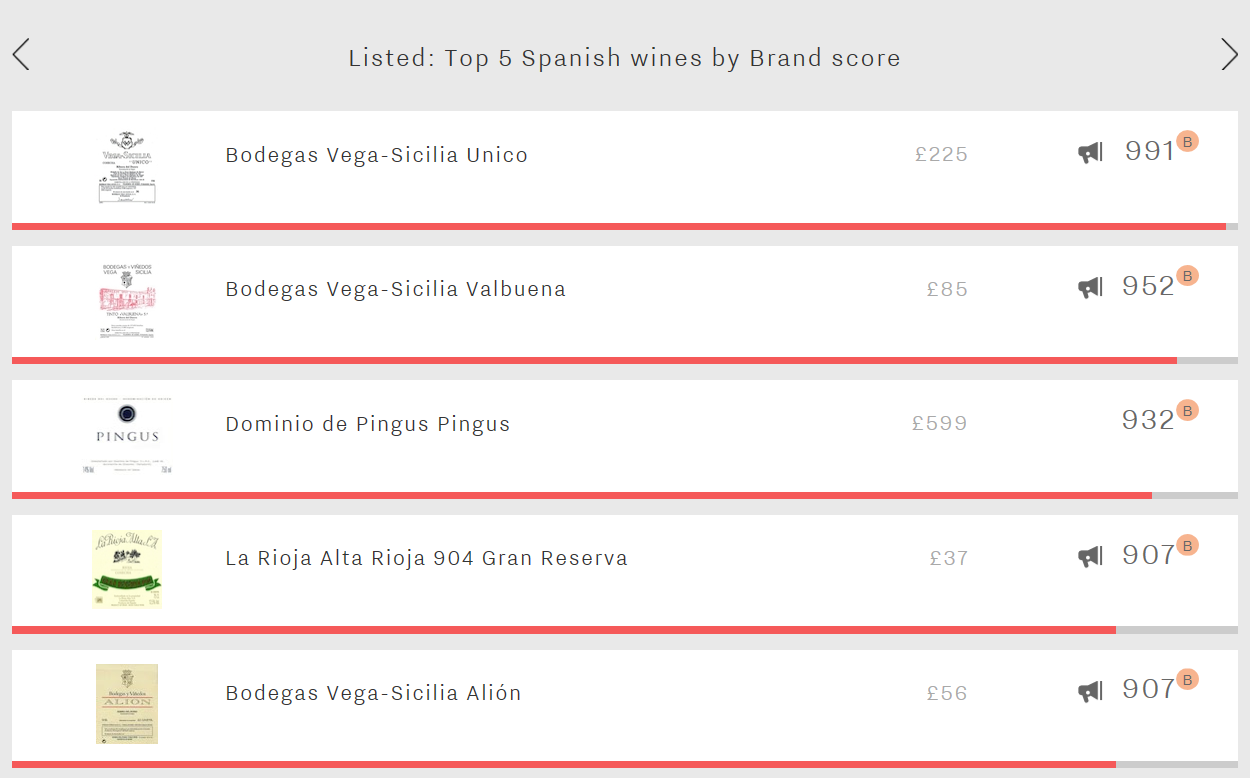
Vega-Sicilia Unico enjoys the best Brand score of any Spanish wine – and is thus the winner of this week’s race. In fact, it also achieves the highest overall Wine Lister score of all Spanish wines (974). Although Unico outperforms the rest of this week’s top five in all three of Wine Lister’s rating categories, its Brand score is particularly impressive (991). This phenomenal score is the result of excellent restaurant presence (47%) and being the 32nd most searched-for of Wine Lister’s wines on Wine Searcher.
Next, with a Brand score of 952 is Vega-Sicilia Valbuena. Despite not being able to match the Bodega’s flagship Unico in any category, it is in terms of brand recognition that it gets closest, its Quality and Economics scores trailing Unico by 115 and 54 points respectively. Its slightly lower – although still impressive – Brand score is the result of being visible in under half the number of restaurants as Unico (23%) and receiving fewer online searches (it is the 119th most popular wine on Wine Lister).
The third wine to make it onto the list is Dominio de Pingus Pingus. Presumably due to its tiny production volumes – only 6,000 bottles of it are produced each year – it is by far the most expensive of this week’s top five, at over twice the price of Unico (£599 vs £225). Its strong Brand – and high price – are supported by excellent Quality, with Pingus achieving the second highest Quality score of the group (935).
The last two places of this week’s top five are occupied by La Rioja Alta 904 Gran Reserva and Vega-Sicilia Alión. Not only do these two have identical Brand scores (907) but, despite contrasting profiles, they also share the same overall score (858). Alión achieves a higher Economics score (874 vs 729), whereas La Rioja Alta 904 records a slightly better Quality score (876 vs 812). La Rioja Alta 904 also shows that strong Brand and Quality scores do not necessarily have to mean soaring prices, as it is by far the most affordable of the five – priced at £37 per bottle on average.
Yquem 2016 released at €250 ex-négociant (same as 2015), with a UK RRP of £264 per bottle (no change on 2015 release price). Quality score 984 (vs 993 in 2015). Our factsheet below summarises all the key points.
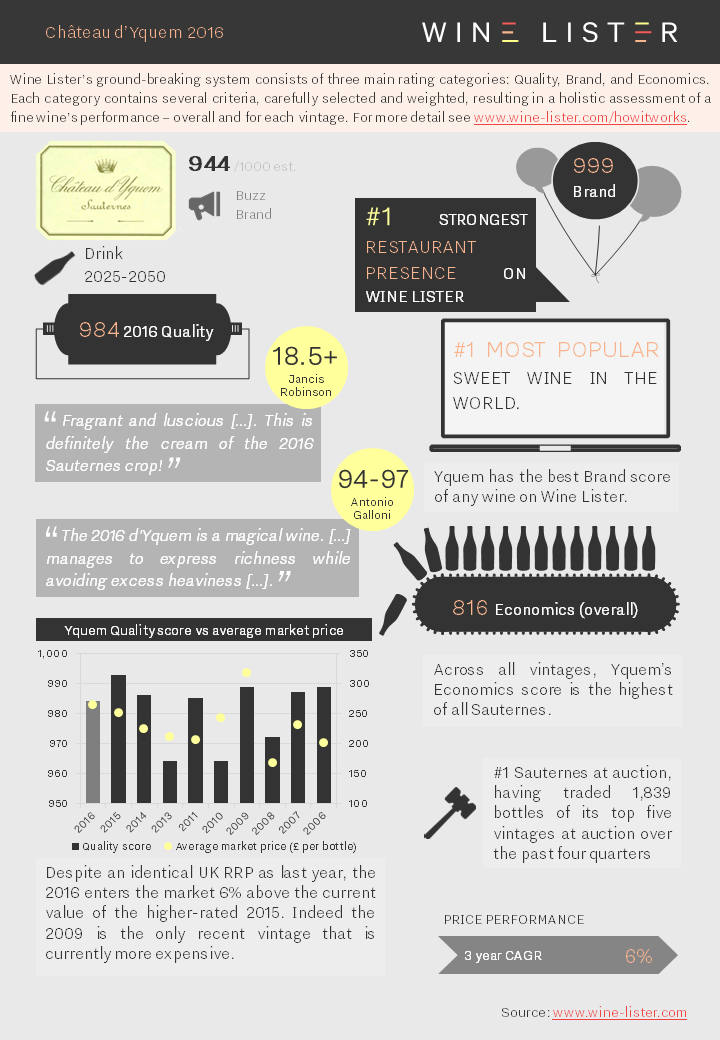
You can download the slide here: Wine Lister Factsheet Yquem 2016
It was with a heavy heart that the global fine wine trade learned of the passing of Barolo legend, Giuseppe Rinaldi, last week. Known for their elegant style and lengthy ageing potential, Rinaldi’s Barolos are not only some of the best that the region has to offer, but also some of the priciest.
In ‘Beppe’ Rinaldi’s honour, Wine Lister looks this week at the top five most expensive wines in Barolo. And there is good reason for these Barolos to be so pricey, with all of the five achieving a Quality score that falls into the “strongest” category on Wine Lister’s 1,000 point scale. On top of this, the first three qualify as Buzz Brands – Wine Lister’s group of wines that combine outstanding restaurant presence with online popularity.
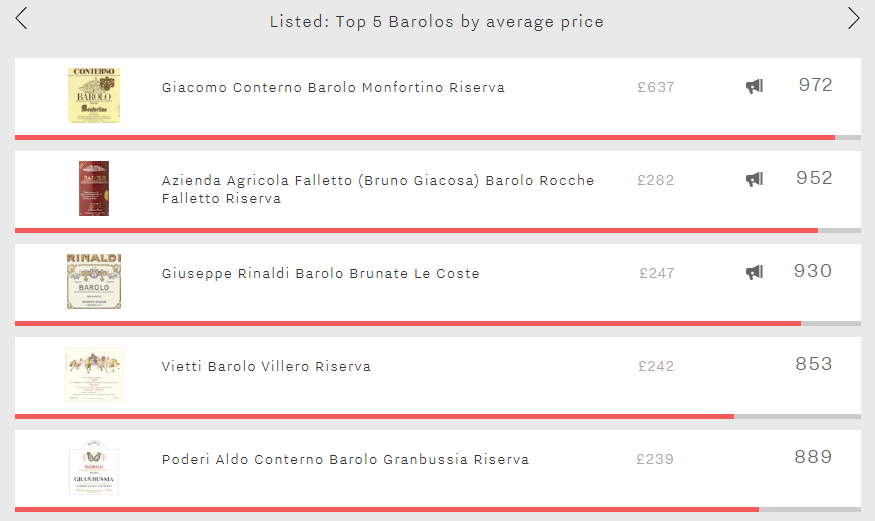
Giacomo Conterno’s Barolo Monfortino Riserva takes first place. At £637 per bottle it is more than twice the price of the rest of this week’s top five. In fact, it is the most expensive Italian wine on Wine Lister. However, it is no coincidence that Conterno’s Monfortino takes first place as it also achieves the group’s best Quality and Brand scores (977 and 969 respectively). Conterno Monfortino is actually the number one Italian wine and 11th best of all wines on Wine Lister, with an impressive overall score of 972.
This week’s second spot is occupied by Azienda Agricola Falletto (Bruno Giacosa) Barolo Rocche Falletto. Even though it competes well with Conterno Monfortino – with Quality and Brand scores of 974 and 914 respectively – it is a considerably cheaper option at £282 per bottle. In fact, despite its lower price, its Economics score is slightly superior to this week’s overall number one wine (969 vs 967), and is the group’s best. Furthermore, it is the second best of all Italian wines on Wine Lister – only beaten by Falletto’s Barbaresco Asili Riserva. The phenomenal Economics score is partly due to a three-year compound annual growth rate (CAGR) of 21.8%.
Giuseppe Rinaldi Barolo Brunate Le Coste takes third place at £247 per bottle. As perfect evidence of Rinaldi’s prowess, it is very consistent across each of Wine Lister’s three rating categories, with each score putting it amongst the very best wines in the world. Confirming its upward trajectory, it records a remarkable three-year CAGR of 36.7% – if it manages to keep that up, it will soon start to narrow the gap to Conterno’s Monfortino in this battle of the Barolos.
The two remaining wines in this group are not only very close in price but they also have the same Quality score (928). This week’s number four – at £242 per bottle – is Vietti Barolo Villero Riserva, followed closely by Poderi Aldo Conterno Barolo Granbussia Riserva at £239. Visible in 17% of the world’s top restaurants, Aldo Conterno’s Granbussia has the second-highest restaurant presence of the group. It is only beaten by this week’s number one, Conterno’s Monfortino, which is visible in 23% of top establishments.












